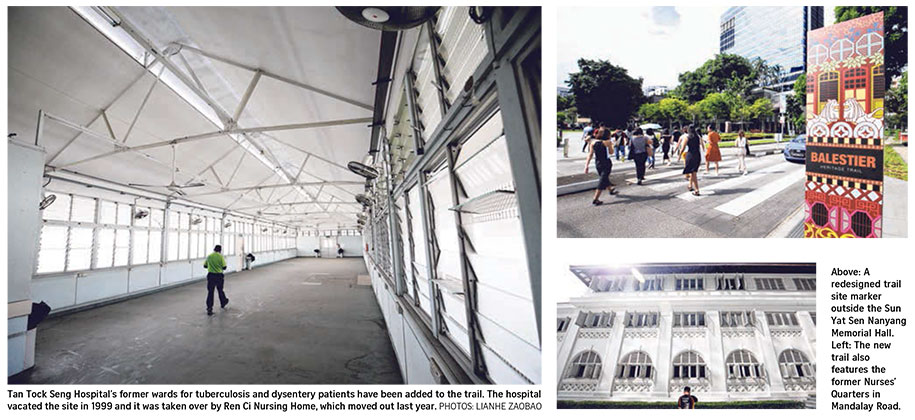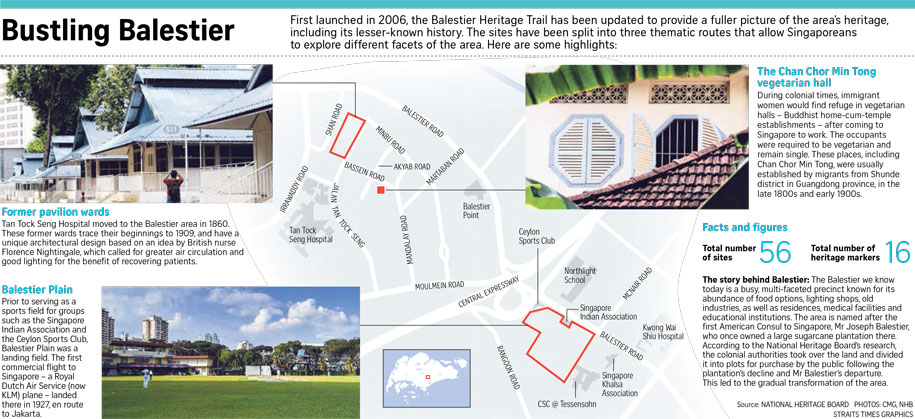Former hospital wards among 30 new additions to area’s history walk
The Straits Times (23 November 2018) - A row of eight single-storey former hospital wards with blue roofs stand on a hill in Moulmein Road. Although they would not look out of place in a war movie, few people in Singapore even know of their existence.
The National Heritage Board (NHB) is aiming to change that by adding the pavilion wards as a stop on its expanded heritage trail in Balestier, which was launched yesterday.

The wards housed Tan Tock Seng Hospital’s tuberculosis and dysentery patients, among others, from 1909. The hospital vacated the site in 1999 and it was taken over by Ren Ci Nursing Home, which moved out last year.
The state-owned property is now managed by the Singapore Land Authority. Built in the style of military hospitals designed by Florence Nightingale, the mother of modern nursing, the wards feature a long central aisle, wide spacing between beds and a high ceiling to let daylight in and improve ventilation, to help in the patients’ recovery.
The Balestier Heritage Trail was launched in 2006. The NHB conducted fresh research and added 30 new sites to the existing 26 yesterday.
The NHB’s assistant chief executive of policy and community Alvin Tan said: “We hope that Singaporeans will be encouraged to venture off the well-trodden path laid out by the previous trail and rediscover Balestier’s heritage anew.”
Rediscover the Area
We hope that Singaporeans will be encouraged to venture off the well-trodden path laid out by the previous trail and rediscover Balestier’s heritage anew."
~ MR ALVIN TAN, NHB’s assistant chief executive of policy and community.
The trail is divided into three routes, each of which follows a different theme – Historical Landmarks Of Balestier Road; Faith, Film And Food; and Building Balestier.
A highlight of the trail is Balestier Point – an 18-storey mixed-use building completed in 1986. It was inspired by Canadian architect Moshe Safdie’s Habitat 67 housing complex in Montreal which features stacked housing units.
Vegetarian halls, or zhaitang in Chinese, are also featured in the trail. During colonial times, immigrant women with no family would take refuge in them after coming to Singapore to work as labourers, seamstresses, cooks or housekeepers.
These Buddhist home-cum temple establishments required their occupants to be vegetarian, to remain single and to perform Buddhist rites.

British cultural anthropologist Marjorie Topley described in a 1954 essay how such halls would provide “care while alive and a funeral at death”, wrote heritage blogger Jerome Lim in a blog post.
One such hall is the Chan Chor Min Tong in Bassein Road. Mr Lim believes its last resident might have last walked its hallways in the 1970s. Some of these halls are open to members of their respective communities only during Chinese New Year.
The trail also traces the evolution of the area’s architecture. It notes for instance that the area was once home to country bungalows from the late 1800s which attracted “Europeans and Eurasians of slender means”.
According NHB research, by 1901, much of Balestier Road was lined by these country bungalows.